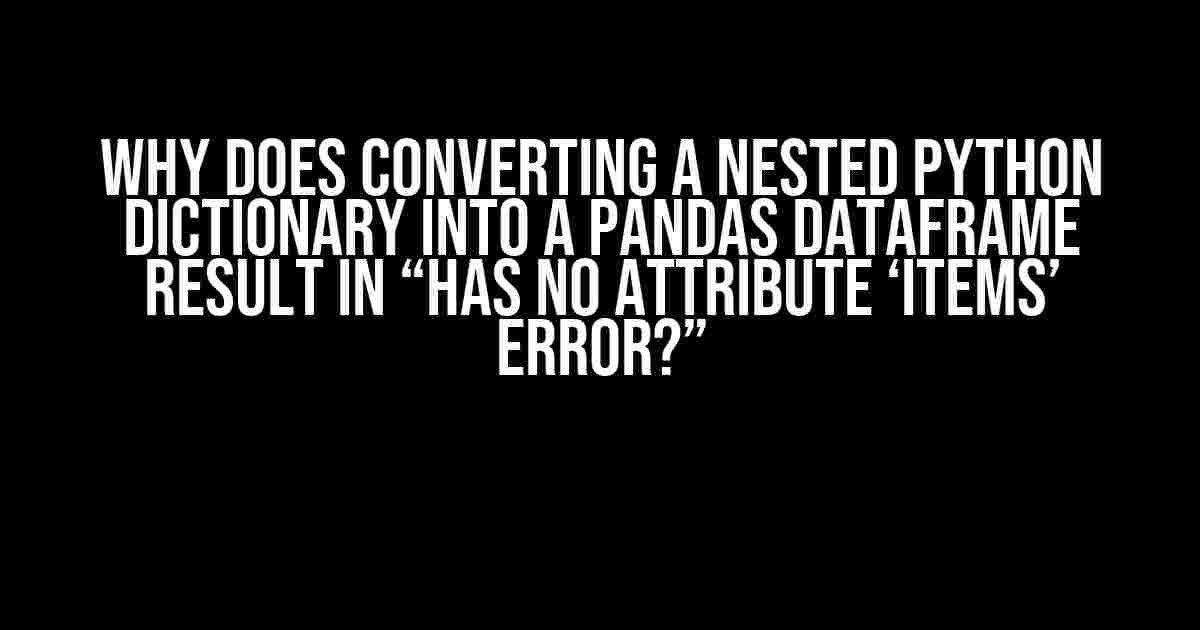If you’re reading this, chances are you’ve stumbled upon a frustrating error while trying to convert a nested Python dictionary into a Pandas DataFrame. The “has no attribute ‘items'” error can be perplexing, especially if you’re new to working with data structures in Python. Fear not, dear reader, for this article will guide you through the root cause of this error and provide you with a comprehensive solution.
What is a Nested Python Dictionary?
Before we dive into the error, let’s quickly review what a nested Python dictionary is. A nested dictionary, also known as a nested object or nested JSON, is a dictionary that contains other dictionaries or lists as its values. Here’s an example:
nested_dict = {
'name': 'John',
'age': 30,
'address': {
'street': '123 Main St',
'city': 'Anytown',
'state': 'CA',
'zip': '12345'
},
'hobbies': ['reading', 'coding', 'hiking']
}
In this example, the `address` key contains another dictionary with its own set of key-value pairs. The `hobbies` key, on the other hand, contains a list of strings.
What is a Pandas DataFrame?
A Pandas DataFrame is a two-dimensional data structure that can store and manipulate large datasets. It’s essentially a table with rows and columns, similar to an Excel spreadsheet or a relational database table. DataFrames are a fundamental component of data science and data analysis in Python.
The Error: “Has No Attribute ‘Items'”
Now, let’s assume you want to convert the `nested_dict` to a Pandas DataFrame using the `pd.DataFrame()` function. You might try something like this:
import pandas as pd
nested_dict = {
'name': 'John',
'age': 30,
'address': {
'street': '123 Main St',
'city': 'Anytown',
'state': 'CA',
'zip': '12345'
},
'hobbies': ['reading', 'coding', 'hiking']
}
df = pd.DataFrame(nested_dict)
However, when you run this code, you’ll encounter the “has no attribute ‘items'” error. This error occurs because the `pd.DataFrame()` function is trying to iterate over the dictionary using the `items()` method, which is not available for nested dictionaries.
Why Does This Error Occur?
The reason for this error lies in the way Pandas handles dictionaries. When you pass a dictionary to the `pd.DataFrame()` function, Pandas expects the dictionary to be a flat, key-value structure. However, in the case of nested dictionaries, Pandas doesn’t know how to handle the nested structures.
In Python, dictionaries have an `items()` method that returns a view object containing the dictionary’s key-value pairs. This method is used by Pandas to convert the dictionary into a DataFrame. However, when the dictionary contains nested structures, the `items()` method won’t work as expected, leading to the “has no attribute ‘items'” error.
Solution: Flattening the Nested Dictionary
To convert a nested dictionary into a Pandas DataFrame, you need to flatten the dictionary first. There are several ways to do this, but one common approach is to use recursion to traverse the nested structure and extract the key-value pairs.
Here’s an example function that flattens a nested dictionary:
def flatten_dict(nested_dict, parent_key='', sep='_'):
flat_dict = {}
for k, v in nested_dict.items():
new_key = f"{parent_key}{sep}{k}" if parent_key else k
if isinstance(v, dict):
flat_dict.update(flatten_dict(v, new_key, sep=sep))
else:
flat_dict[new_key] = v
return flat_dict
This function takes a nested dictionary, a parent key (optional), and a separator character (default is ‘_’) as inputs. It recursively traverses the nested structure, extracting key-value pairs and flattening them into a single dictionary.
Converting the Flattened Dictionary to a Pandas DataFrame
Once you’ve flattened the nested dictionary, you can convert it to a Pandas DataFrame using the `pd.DataFrame()` function:
import pandas as pd
nested_dict = {
'name': 'John',
'age': 30,
'address': {
'street': '123 Main St',
'city': 'Anytown',
'state': 'CA',
'zip': '12345'
},
'hobbies': ['reading', 'coding', 'hiking']
}
flat_dict = flatten_dict(nested_dict)
df = pd.DataFrame([flat_dict])
print(df)
This code will output a Pandas DataFrame with the following structure:
| name | age | address_street | address_city | address_state | address_zip | hobbies |
|---|---|---|---|---|---|---|
| John | 30 | 123 Main St | Anytown | CA | 12345 | [‘reading’, ‘coding’, ‘hiking’] |
Note that the `hobbies` column contains a list of strings, which might not be ideal for data analysis. You may want to consider converting the list to a more suitable data structure, such as a comma-separated string or separate rows for each hobby.
Conclusion
In this article, we’ve explored the “has no attribute ‘items'” error that occurs when trying to convert a nested Python dictionary into a Pandas DataFrame. We’ve discussed the root cause of this error and provided a comprehensive solution involving flattening the nested dictionary using recursion.
By following the instructions outlined in this article, you should be able to convert your nested dictionary into a Pandas DataFrame and start analyzing your data with ease. Remember to flatten your dictionary before converting it to a DataFrame, and don’t hesitate to reach out if you have any further questions or need additional assistance.
Further Reading
If you’re interested in learning more about working with nested dictionaries and Pandas DataFrames, here are some additional resources:
- Python Documentation: collections.OrderedDict
- Pandas Documentation: DataFrame
- Stack Overflow: Convert a nested Python dictionary to a Pandas DataFrame
We hope this article has been informative and helpful. Happy coding!
Frequently Asked Question
Get ready to dive into the world of nested Python dictionaries and Pandas DataFrames!
What’s the deal with converting nested Python dictionaries to Pandas DataFrames?
When you try to convert a nested Python dictionary to a Pandas DataFrame, Pandas gets confused about how to handle the nested structure. By default, Pandas expects a flat dictionary with key-value pairs, not nested ones. That’s why you get the “has no attribute ‘items'” error!
Is it because of the way I structure my nested dictionary?
You’re on the right track! The error can occur if your nested dictionary has lists or other non-dictionary objects as values. Pandas gets lost when trying to iterate over these non-dictionary values, resulting in the “has no attribute ‘items'” error. Make sure to normalize your dictionary structure before converting it to a DataFrame.
Can I use the `pd.json_normalize()` function to fix this issue?
Yes, yes, yes! The `pd.json_normalize()` function is specifically designed to handle nested dictionaries and JSON data. It will flatten your nested structure into a tabular format, making it easy to convert to a Pandas DataFrame. Give it a try and say goodbye to the “has no attribute ‘items'” error!
What if I have a complex nested dictionary with multiple levels of nesting?
Don’t worry, we’ve got you covered! For complex nested dictionaries, you can use a combination of `pd.json_normalize()` and recursive functions to flatten the structure. You can also use libraries like `pandas.io.json.json_normalize` or `json` to help with the flattening process. Remember to be patient and takes your time to carefully craft a solution that fits your specific use case.
Are there any other common mistakes I should watch out for when converting nested dictionaries to DataFrames?
One common mistake is not paying attention to the data types of your dictionary values. Make sure to convert any non-numeric values to a suitable data type before creating the DataFrame. Additionally, be mindful of missing or null values, as they can cause issues during the conversion process. Finally, don’t forget to check the resulting DataFrame for any unexpected columns or data types!


